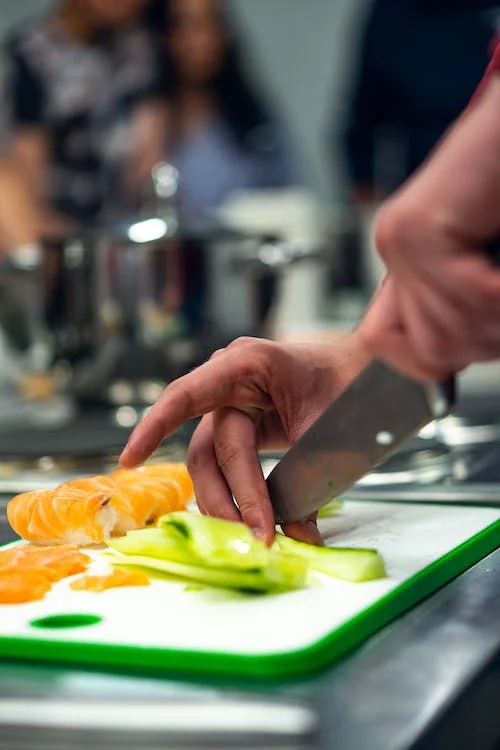From slicing meat, chopping vegetables to boning fish, having the best kitchen knife is a must for your success in the kitchen. Though it seems practical to aim for one reliable knife that can get it all done, there’s a certain type of knife intended to help you with each specific chore. By getting all the essential types, you get to build a knife collection that can make food preparation easier, faster, and safer. So, let’s cut through the chase! Here’s a guide to the kitchen knives you only need for your day-to-day cooking tasks, as well as some valuable tips on how and when to use them, for a better time in the kitchen!
1. Chef’s Knife
A classic chef’s knife is one of the most essential knives in the kitchen. It’s a super sharp, decent-sized knife, usually, 8 to 10 inches in length. Its blade is well-rounded going to end before reaching a straight edge, making it perfect for a variety of tasks. Others opt for a longer knife, as the longer blade entails more coverage, allowing you to do more work. Plus, it also provides better safety, given that there’s more blade to cut you can use to slice through the ingredient.
When to use it: A chef’s knife is a versatile and efficient knife. You can use it to dice fruits, chop vegetables, or thinly slice meat. Though often dubbed as a kitchen workhorse, you must never use it to puncture cans, skin large vegetables, or butcher poultry. Its width makes it unfit for the said tasks, which can be accomplished by other smaller knives.
2. Serrated Knife
A serrated knife is a knife with a sharp, toothed blade, usually used for slicing bread. Thus, resulting in its more familiar name for most people and brands – the bread knife. It typically runs 5 to 12 inches in length, featuring a long and flat, with little to no curve. Though people often restrict them for slicing pieces of bread, serrated knives can be pretty all-around, capable of taking on any tasks that the chef’s knife’s straight blade cannot accomplish.
When to use it: A serrated knife is ideal for any food with a hard exterior or a waxy surface but softer flesh, such as tomatoes or pineapples. The sawing motion from the toothed edges makes grips and pierces through the hardy and slippery food coverings, which a straight blade can’t puncture or just slip off. Slicing crusty bread or baguettes are sure fun using serrated knives, but you might be surprised how they can also take on pineapples, peppers, pineapples, and citrus with ease.
3. Paring Knife
Like the serrated knife, a paring knife is a knife that carries on tasks a chef’s knife leaves off. It’s a small, all-rounder tool, usually running 3 to 4 inches in length, with a slightly curved blade and sharp pointed tips. It’s ideal for any type of food that requires utmost precision and attention to detail, which is something larger knives cannot provide.
When to use it: Utilize a paring knife if you’re dealing with tasks that need extra dexterity. These include peeling potatoes or apples, hulling strawberries, or deveining shrimp. It’s an excellent choice for mincing garlic, julienning vegetables, or slicing other times that are too small for a chef’s knife’s long blade.
Just be mindful to avoid using them on harder vegetables like parsnips, carrots, or pumpkin. These small knives don’t have ample weight to slice through these vegetables and may require you to exert extra force just to pierce them. In turn, you lose precision with the extra pressure you used, making it more likely for the knife to slip and cause accidents.
4. Boning Knife
As its name suggests, a boning knife is an ideal blade for boning meat, poultry, or fish of various sizes, whether it’s a small herring or a 200-pound pork leg. This type of knife has thinner blades than most types of knives. They can be stiff or flexible but both are designed to slice in straight lines. Remember, boning knives are not intended to cut bones, but rather to cut around them and separate the meat neatly from bones. You can see some boning blades curve dramatically, making the task relatively easier.
When to use it: You can use a stiff boning knife to debone pork and beef. The more flexible types can be used for deboning chicken or fish, as well as removing the latter’s skin to make fillets. Don’t think solely about meat, though. A boning knife is also suitable for peeling the skin of fruits without cutting much flesh underneath or for cutting cakes or cake layers more precisely.
Takeaway
There are lots of other types of kitchen knives available, all designed for a specific purpose. For simple everyday cooking tasks, these four are more than enough to get the job done. However, don’t limit yourself. As you tackle more complicated dishes or types of cuisines, be sure to equip yourself with the right knives and tools to make the experience more fun and rewarding. Happy cooking!

